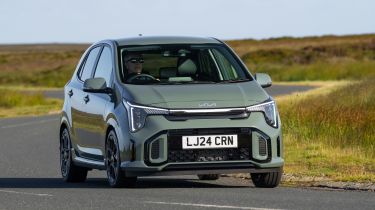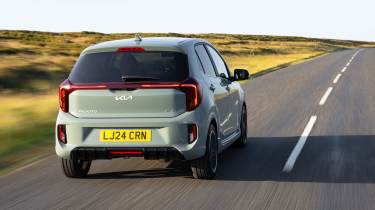Kia Picanto review - Engines, drive & performance
The Kia Picanto is more about ease than fun, but is enjoyable nonetheless
We’ve already tested the facelifted Kia Picanto in 1.0-litre three-cylinder guise. As before, despite the limited power on offer, the Picanto’s light weight means it’s very agile and feels nippier than you might expect, especially in city driving. Hold onto a gear for too long, though, and you do feel the drop off in power at higher revs quite noticeably.
The Picanto’s steering feels quite weighty, yet quick, which gives it a more substantial feel that helps the Picanto feel like a bigger, more grown-up car. We like the feeling of the five-speed manual transmission, which is solid and precise, though be aware that you have to change gear quite frequently to get the best out of the engine.
All of those attributes actually make the Kia Picanto fun to drive on slower, twisty B-roads where the sensation is that you’re going faster than you are, but take it onto larger stretches of open road and it can start to feel a little out of its depth. On the motorway it shows itself up somewhat, with quite noticeable wind and road noise, not to mention the intrusive sound of the three-cylinder engine working hard. We’d say it’s best suited to drivers who will only take occasional longer journeys.
The suspension setup of the Picanto is mostly good, with a comfortable ride over the majority of smaller road imperfections, but the occasional larger pothole or speed bump can be felt quite noticeably.
Kia Picanto petrol engines
The 62bhp 1.0-litre engine is well-suited to urban use but it’s also happy on country lanes and not entirely out of its comfort zone when called upon to make a long journey. Its 0-62mph performance is modest on paper at 15.4 seconds, but it doesn’t feel at all lethargic when pulling away; it’s at higher speeds where acceleration really tails off. Go for the automatic and that sprint is even slower, taking 18.2 seconds.
Following the facelift, Kia discontinued the previous 1.0-litre turbocharged engine with 99bhp and replaced it with a naturally-aspirated 77bhp 1.2-litre four-cylinder engine available on GT-Line S models only. This offers a slightly quicker 0-62mph time of 13.1 seconds with the manual gearbox, and 16.5 seconds with the automatic transmission. We’ve not yet driven it, but we expect it may be a better option for motorway driving in comparison to the 62bhp 1.0-litre three-cylinder.











